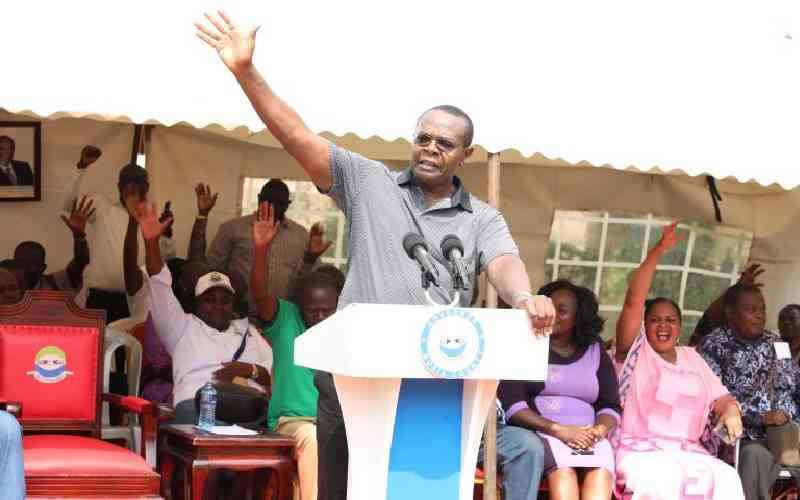As soon as little *Edna was born, the doctors discovered that she had difficulties breathing and needed oxygen supplementation.
“She was also very floppy and could not even move a finger,” her mother Wangui says as she recalls the worry that greeted the arrival of her newborn.
Thankfully, doctors managed to stabilise her condition and she was discharged.
But Edna continued to display worrying symptoms that left her parents concerned. They noticed that she had delays in controlling her head, sitting up, rolling over, crawling, talking or even walking.
When Edna was three, her parents sent a blood sample to a genetic lab abroad.
“We arrived at this decision because every time we would seek medical advice on reasons for the delays in her growth milestones, the doctors made all sorts of diagnoses that left us confused. I guess they had never come across a condition like hers,” Wangui says.
From the genetic test, they discovered that their child was harboring a rare condition known as RYR-1-Myopathy.
This is an inherited form of muscle weakness and varies in severity from mild weakness to severe disability. The condition is due to inability by muscles to process calcium, a critical component of muscle contraction. Generally, people with this condition have muscle weakness and long narrow faces.
They also experience difficulties in chewing and swallowing, and may need interventions like feeding tubes.
According to Eugene Kalman Genga, a rheumatologist, the RYR-1-Myopathy is also known as Ryanodine Receptor 1-Related Myopathies.
“It belongs to a larger group of congenital myopathies. The term ‘congenital myopathy’ refers to a group of muscle conditions that are caused by a genetic mutation that you are born with and leads to muscle weakness. It mainly affects children and have no gender bias,” Dr Genga says.
RYR-1 related diseases are conditions caused by changes (mutations) in the RYR-1 gene.
The RYR-1 gene provides instructions for production of the RYR-1 receptor, a channel in the skeletal muscle cells that regulates flow of calcium, a critical component of muscle contraction. A reduced number and/or abnormal RYR-1 receptors can lead to symptoms like dysfunctional muscle contraction, weakness, susceptibility to malignant hyperthermia, rhabdomyolysis, and other exercise and/or heat-induced symptoms.
“There are two main types of inheritance patterns for changes in the RYR-1 gene: autosomal recessive and autosomal dominant. In understanding inheritance patterns of a genetic disease, it should be remembered that all individuals have two ‘copies’ of each gene, one inherited from the mother and one from the father,” Dr Genga says.
When one has a recessive gene, it means that both copies (alleles) of the gene must have mutations for the patient to be affected clinically; if only one allele possesses a mutation, the patient will be a carrier and will generally not be affected clinically. Meanwhile dominant means that only one allele of the gene must possess a mutation for the individual to be clinically affected.
Stay informed. Subscribe to our newsletter
Thus, RYR-1-Myopathy is a rare, poorly understood disease that is commonly misdiagnosed.
“Common symptoms include weakness of the eye muscles (opthalmoparesis) and generalised muscle weakness, typically affecting the muscles closest to the torso of the body (proximal muscle weakness),” Dr Genga says.
In babies, parents should look out for signs of weakness, particularly in the upper legs and hips. “Affected infants appear floppy and can delay the development of motor skills such as sitting, standing and walking. In severe cases, affected infants experience profoundly weak muscle tone (hypotonia), resulting in feeding difficulties and serious or life-threatening breathing problems,” Genga says.
Some individuals, however, experience muscle cramping and pain, reduced exercise tolerance, and intolerance to heat. Individuals with RYR-1-related diseases can experience static symptoms or dynamic symptoms, or a combination of both.
These symptoms may either be static (meaning they are present at all times) or dynamic (meaning they are transient based on certain triggers or precipitants such as malignant hyperthermia, exercise induced breakdown of skeletal muscle (rhabdomyolysis), myalgia (muscle pain), muscle cramps and fatigue.
Diagnosis
The most definitive diagnostic test for RYR-1-related diseases is genetic testing. A genetic test is often ordered due to suspicion related to clinical signs and symptoms, family history, muscle biopsy and muscle MRI.
Muscle biopsy evaluates for changes in the muscle cell that may be associated with mutations in the RYR-1 gene (like CCD, MMD, CNM, CFTD). Muscle MRI allows the physician to evaluate for muscle damage throughout the body, with varying patterns being associated with various forms of muscular dystrophies and myopathies, including subtypes of RYR-1 myopathy.
Treatment
It usually requires a multi-disciplinary team involving the neuro-muscular physician, orthopedic surgeon, pulmonologist, cardiologist, gastroenterologist/dietician, geneticist/genetic counselor, physiatrist, physical/occupational/speech therapists, orthotist and palliative care physician. The focus on treatment of the congenital myopathies is to evaluate and slow the progression of symptoms while maintaining activities of daily living.
At this time, no cure or treatment exists for RYR-1 myopathy.
“Seeing as there is no permanent cure for the condition, we manage her with therapy appointments at least three to four times a week. We also feed her through a feeding tube inserted directly into her tummy. We supplement her oxygen when need be, especially when unwell and when sleeping,” Wangui says of Edna’s condition.
She knows of no other family member with such a condition.
Doctors recommend that for patients with breathing difficulties, being aware of signs is relevant. “Neuromuscular weakness is often more prevalent during sleep. As such, evaluation of signs of hypoventilation at night, including morning headaches, snoring, or daytime sleepiness, should be undertaken. In infants, respiratory support for frequent or prolonged respiratory illnesses may be needed,” Dr Genga says.
The first-ever reported case of this rare condition was in 1956. Studies have reported one in 26,000 (mainly pediatric) cases in the US and one in 135,000 (adult and pediatric) in the UK.
In Kenya, there is no data to show how common it is.
(*Not her real name)
 The Standard Group Plc is a
multi-media organization with investments in media platforms spanning newspaper
print operations, television, radio broadcasting, digital and online services. The
Standard Group is recognized as a leading multi-media house in Kenya with a key
influence in matters of national and international interest.
The Standard Group Plc is a
multi-media organization with investments in media platforms spanning newspaper
print operations, television, radio broadcasting, digital and online services. The
Standard Group is recognized as a leading multi-media house in Kenya with a key
influence in matters of national and international interest.
 The Standard Group Plc is a
multi-media organization with investments in media platforms spanning newspaper
print operations, television, radio broadcasting, digital and online services. The
Standard Group is recognized as a leading multi-media house in Kenya with a key
influence in matters of national and international interest.
The Standard Group Plc is a
multi-media organization with investments in media platforms spanning newspaper
print operations, television, radio broadcasting, digital and online services. The
Standard Group is recognized as a leading multi-media house in Kenya with a key
influence in matters of national and international interest.




